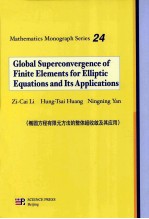图书介绍
椭圆方程有限元方法的整体超收敛及其应用 英文版PDF|Epub|txt|kindle电子书版本网盘下载

- 李子才,黄宏财,严宁宁著 著
- 出版社: 北京:科学出版社
- ISBN:9787030334794
- 出版时间:2011
- 标注页数:324页
- 文件大小:11MB
- 文件页数:341页
- 主题词:椭圆型方程-有限元法-超收敛-研究-英文
PDF下载
下载说明
椭圆方程有限元方法的整体超收敛及其应用 英文版PDF格式电子书版下载
下载的文件为RAR压缩包。需要使用解压软件进行解压得到PDF格式图书。建议使用BT下载工具Free Download Manager进行下载,简称FDM(免费,没有广告,支持多平台)。本站资源全部打包为BT种子。所以需要使用专业的BT下载软件进行下载。如BitComet qBittorrent uTorrent等BT下载工具。迅雷目前由于本站不是热门资源。不推荐使用!后期资源热门了。安装了迅雷也可以迅雷进行下载!
(文件页数 要大于 标注页数,上中下等多册电子书除外)
注意:本站所有压缩包均有解压码: 点击下载压缩包解压工具
图书目录
Chapter 1 Basic Approaches1
1.1 Introduction1
1.2 Simplified Hybrid Combined Methods3
1.3 Basic Theorem for Global Superconvergence6
1.4 Bilinear Elements8
1.5 Numerical Experiments12
1.6 Concluding Remarks15
Chapter 2 Adini's Elements17
2.1 Introduction17
2.2 Adini's Elements19
2.3 Global Superconvergence22
2.3.1 New error estimates22
2.3.2 A posteriori interpolant formulas25
2.4 Proof of Theorem 2.3.132
2.4.1 Preliminary lemmas32
2.4.2 Main proof of Theorem 2.3.139
2.5 Stability Analysis40
2.6 New Stability Analysis via Effective Condition Number41
2.6.1 Computational formulas42
2.6.2 Bounds of effective condition number44
2.7 Numerical Experiments and Concluding Remarks48
Chapter 3 Biquadratic Lagrange Elements55
3.1 Introduction56
3.2 Biquadratic Lagrange Elements57
3.3 Global Superconvergence59
3.3.1 New error estimates59
3.3.2 Proof of Theorem 3.3.167
3.3.3 Proof of Theorem 3.3.273
3.3.4 Error bounds for Q8 elements73
3.4 Numerical Experiments and Discussions74
3.4.1 Global superconvergence75
3.4.2 Special case of h=k and fxxyy=077
3.4.3 Comparisons78
3.4.4 Relation between uh and ?80
3.5 Concluding Remarks83
Chapter 4 Simplified Hybrid Method for Motz's Problems85
4.1 Introduction85
4.2 Simplified Hybrid Combined Methods86
4.3 Lagrange Rectangular Elements89
4.4 Adini's Elements96
4.5 Concluding Remarks99
Chapter 5 Finite Difference Methods for Singularity Problems101
5.1 Introduction101
5.2 The Shortley-Weller Difference Approximation102
5.3 Analysis for uD h with no Error of Divergence Integration106
5.4 Analysis for uh with Approximation of Divergence Integration112
5.5 Numerical Verification on Reduced Convergence Rates120
5.5.1 The model on stripe domains120
5.5.2 The Richardson extrapolation and the least squares method124
5.6 Concluding Remarks128
Chapter 6 Basic Error Estimates for Biharmonic Equations130
6.1 Introduction130
6.2 Basic Estimates for ∫∫Ω(u-uI)xxvxxds136
6.3 Basic Estimates for ∫∫Ω(u-uI)xyvxyds141
6.4 New Estimates for ∫∫Ω(u-uI)xyvxyds for Uniform Rectangular Elements147
6.5 New Estimates for ∫∫Ω(u-uI)xxvyyds152
6.6 Main Theorem of Global Superconvergence157
6.7 Concluding Remarks158
Chapter 7 Stability Analysis and Superconvergence of Blending Problems160
7.1 Introduction160
7.2 Description of Numerical Methods162
7.3 Stability Analysis167
7.3.1 Optimal convergence rates and the uniform VO h-elliptic inequality167
7.3.2 Bounds of condition number170
7.3.3 Proof for Theorem 7.3.4174
7.4 Global Superconvergence179
7.5 Numerical Experiments and Other Kinds of Superconvergence184
7.5.1 Verification of the analysis in Section 7.3 and Section 7.4184
7.5.2 New superconvergence of average nodal solutions188
7.5.3 Superconvergence of L∞-norm189
7.5.4 Global superconvergence of the a posteriori interpolant solutions190
7.6 Concluding Remarks190
Chapter 8 Blending Problems in 3D with Periodical Boundary Conditions192
8.1 Introduction192
8.2 Biharmonic Equations194
8.2.1 Description of numerical methods194
8.2.2 Global superconvergence197
8.3 The BPH-FEM for Blending Surfaces201
8.4 Optimal Convergence and Numerical Stability206
8.5 Superconvergence207
Chapter 9 Lower Bounds of Leading Eigenvalues212
9.1 Introduction212
9.1.1 Bilinear element Q1213
9.1.2 Rotated Q1 element(Qrot 1)213
9.1.3 Extension of rotated Q1 element(EQrot 1)214
9.1.4 Wilson's element214
9.2 Basic Theorems216
9.3 Bilinear Elements219
9.4 Qrot 1 and EQrot 1 Elements221
9.4.1 Proof of Lemma 9.4.1225
9.4.2 Proof of Lemma 9.4.2226
9.4.3 Proof of Lemma 9.4.3227
9.4.4 Proof of Lemma 9.4.4230
9.5 Wilson's Element232
9.5.1 Proof of Lemma 9.5.1234
9.5.2 Proof of Lemma 9.5.2237
9.5.3 Proof of Lemma 9.5.3 and Lemma 9.5.4238
9.6 Expansions for Eigenfunctions239
9.7 Numerical Experiments241
9.7.1 Function ρ=1242
9.7.2 Function ρ≠0248
9.7.3 Numerical conclusions251
Chapter 10 Eigenvalue Problems with Periodical Boundary Conditions253
10.1 Introduction253
10.2 Periodic Boundary Conditions256
10 3 Adini's Elements for Eigenvalue Problems258
10 4 Error Analysis for Poisson's Equation260
10.5 Superconvergence for Eigenvalue Problems263
10.6 Applications to Other Kinds of FEMs265
10.6.1 Bi-quadratic Lagrange elements265
10.6.2 Triangular elements266
10.7 Numerical Results267
10.8 Concluding Remarks273
Chapter 11 Semilinear Problems274
11.1 Introduction274
11.2 Parameter-Dependent Semilinear Problems276
11.3 Basic Theorems for Superconvergence of FEMs279
11.4 Superconvergence of Bi-p(≥2)-Lagrange Elements286
11.5 A Continuation Algorithm Using Adini's Elements294
11.6 Conclusions296
Chapter 12 Epilogue297
12.1 Basic Framework of Global Superconvergence297
12.2 Some Results on Integral Identity Analysis300
12.3 Some Results on Global Superconvergence302
Bibliography306
Index320